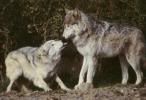
Wildside
Endangered Species & Wild Animals
All content © by Diana L. Guerrero unless otherwise noted and may not be reprinted without prior written permission. All rights reserved. Click here for reprint permissions and fees.
Wildside: Wolf Handling Course
Learn about a unique class for training wolf professionals the nuances of wolf handling, wolf management, and wolf veterinary medical procedures. The California Wolf Center holds a course every year at their wolf facility in Julian, California.
Learning about Lobo: Wolf Handling Course
It was still dark when I arose. At one time this would have been a daily occurrence, but now the luxury of lounging in bed until 7 am is something I cherished. However I managed to get the critters fed and cared for and hit the road just as the light was began to illuminate the sky.
A few months prior, I was giving a seminar and another animal professional invited me up to a wolf sanctuary just over an hour from where I reside. She thought January would be a good time for me to visit, meet the staff, and familiarize myself with their current efforts. Each year they have what they call a wolf roundup --a time when they bring out a wildlife veterinarian to perform the annual exams and vaccinations for the dozen or so wolves.
During this time they also had the foresight to gather together interested parties for a three day seminar that would not only train them in capture, restraint, immobilization and exams, but that would give them practical lab work that would ingrain the experience into their cellular memory.
My journey was pleasant but cold as I climbed in altitude. Every slow truck conspired to delay my trip that morning. For some reason I imagined that I had missed the facility. So I stopped to check my bearings and grab a warm drink. No, I had not missed the facility but by now I was already later than I had anticipated.
As I drove up to the main gate the guard gave me access and met me at a second gate to give me directions. As I drove into the actual facility I could see the wolves moving in the distance. True to the behavior of the species, they were wary in response to a strange vehicle. I was glad to recognize several vehicles as I parked and proceeded to find my way to the seminar that was already underway. It was the second day and I had no idea about what to expect.
This particular course was titled, Wolf Handling With Veterinary Perspectives. Patrick Valentino, the director of the California Wolf Center (CWC), met me and brought me in. The room resembled some of the lodges that I had encountered in my past when I lived or visited more remote areas. It was spacious but warm and inviting.
As I scanned the room there was a wide variety of attendees. There were several students from local universities and then a wide variety of animal professionals. Some were into behavior; others were keepers, while others ran a variety of other animal facilities or services.
The Wolf Center was founded back in 1977 just outside of Julian, California. Their mission is to heighten awareness and conservation efforts for protecting and understanding the wolf and ALL North American wildlife. Currently the center is home to several packs of Alaskan gray wolves and the endangered Mexican gray wolf.
Seminar attendees were from as far away as Norway, Montana, Lake Tahoe, San Francisco, Santa Cruz, and Durango (Mexico). But the local region of San Diego had also drawn a fair number. I was amazed at how many people I actually knew within the group and also happy to reacquaint myself with a few people that I had lost touch with.
As I attempted to gain my bearings, I realized that I had landed right in the middle of the chemical immobilization part of the seminar. My rusty veterinary course work was going to be updated, something that was good but very demanding of my brain cells, and something that made me glad that I had stopped for some coffee. Nothing like a good dose of caffeine!
It was an interesting morning and I was happy to participate as an observer. I learned that the first day had been spent on methods of organizing wolf-handling operations, legal responsibilities associated with chemical immobilization, non-chemical capture, captive wolves, escaped wolves, physical restraint and drug delivery systems. Day one also included a practical lab where everyone practiced using restraint tools and different immobilization delivery systems.
Today the students were calculating dosages and learning about combinations and actions of the different drugs used for wildlife chemical immobilization. Safety, handling tips and the finer nuances of this work were discussed along with the actual goals of the physical exam.
Just as they would have to do out in the field, everyone had to hike out and eyeball the two wolves that would be chemically immobilized the following day. (From the distance we observed them from my guess was 70# each.) The wide range of guesstimates (from 65 to 108) was thrown back to the attendees and the question was, how were THEY going to calculate the doses? The actual weight would be confirmed the next day during the actual exam. (They were 67.5 & 68.5)
Next, preventative measures and procedures were discussed, patient monitoring, veterinary emergencies and the prevention of them were also covered. Later, the practical lab would consist of actually doing mock exams on dogs in simulated conditions. These same blustery conditions would be encountered during the live handling and capture on day three.
Mark Johnson, the veterinarian teaching the seminar, had a wide variety of practical experiences to share that were enhanced by his slides and his stories. His easy going manner and habit of asking the students what they wanted to do and how they would calculate or respond encouraged even the most unsure.
Students commented how he truly conveyed and instilled in them the feeling that there were no silly replies and likewise no stupid answers or questions. It was apparent that he infused a sense of comfort and trust within his students. This created openness for dialog and problem solving in a dynamic way.
With wolf and bear field experience throughout the United States Dr. Johnson is a veteran. His Wildlife Veterinary Resources is based out of Bozeman, Montana and he has served as project veterinarian for the Yellowstone and Idaho gray wolf reintroduction programs. Additionally, he provides training, consulting, support and field assistance for the gray and Mexican Wolf recovery programs. Dr. Mark also provides another course that covers other species called Wildlife Handling With Veterinary Perspectives.
In their combined effort, the California Wolf Center and Wildlife Veterinary Resources provide a continuing education opportunity that animal facilities or animal professionals should take advantage of. Students completing the course are certified in wolf handling procedures. (Professional and academic credit is available.) The course also allows opportunities for networking and establishing professional contacts throughout the United States and other countries.
The California Wolf Center is currently working as part of the species survival (SSP) plan for the Mexican Wolf. Their goals are to increase their holding, breeding and educational efforts around this project.
The center, although closed to the public, presents educational programs about wolves once a week. Visitors must make a reservation to attend. (Saturdays at 2pm. Call 760.765.0030 for current fees.) The event provides a well-rounded lecture, slide show and video prior to wolf viewing.
In addition, the wolf center offers memberships and an impressive collection of quality wolf products. Copy this URL and visit their web site at <http://www.californiawolfcenter.org> for more information.
For seminars on Wildlife Handling and other services contact Dr. Mark Johnson via Wildlife Veterinary Resources at <http://www.wildlife-vet.com>.
Students informed me that the wolf roundup went well. My personal thanks to Dr. Mark, Patrick Valentino, the CWC staff, and all the participants for their hospitality and assistance with this article.
About this animal expert: Since 1978 Diana L. Guerrero has worked professionally with both wild and domestic animals. Guerrero has been affiliated with, and certified by, a variety of animal programs in the USA and Europe. Based in California, she writes, consults, and speaks. Information on her animal career programs, training courses, and her books {What Animals Can Teach Us about Spirituality (SkyLight Paths, 2003), Blessing of the Animals (Sterling, 2007), Help! My Pet is Driving Me Crazy (Guerrero Ink, 2007), Animal Disaster Preparedness for Pet Owners & Pet Professionals (Guerrero Ink, 2007)} can be found in this web site and in the shop. Questions for Guerrero should be submitted via the blog comments or membership forum.






